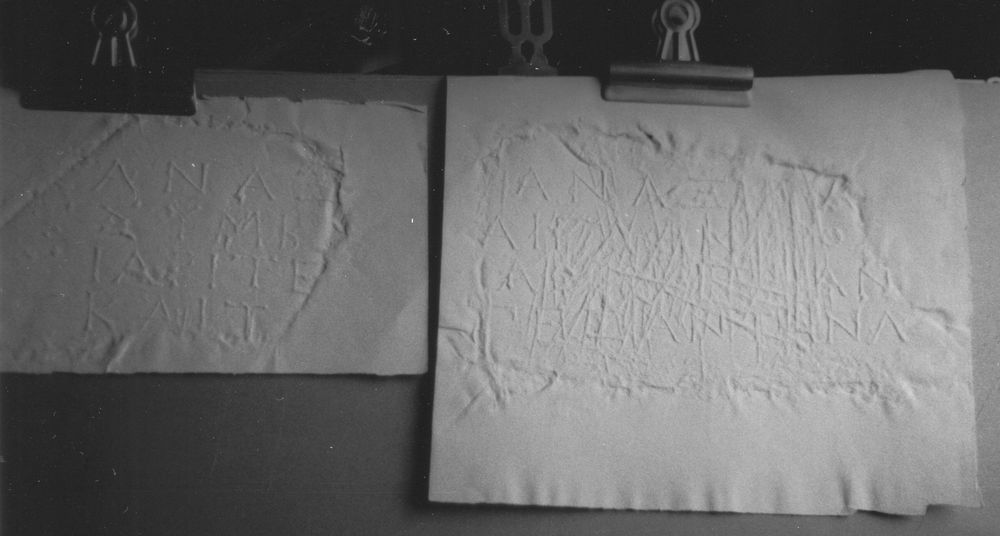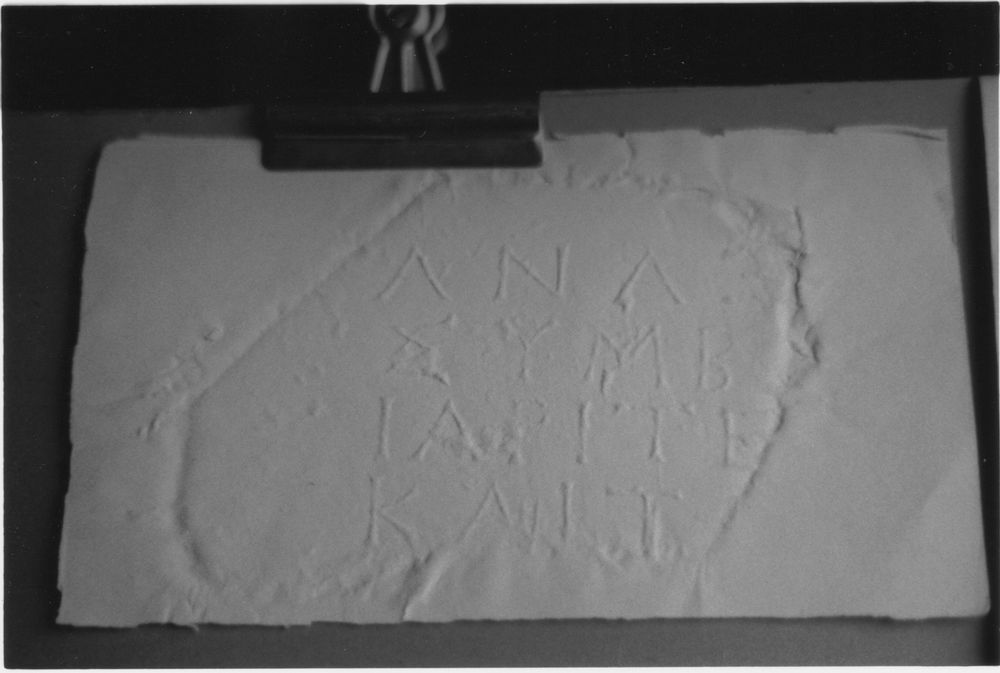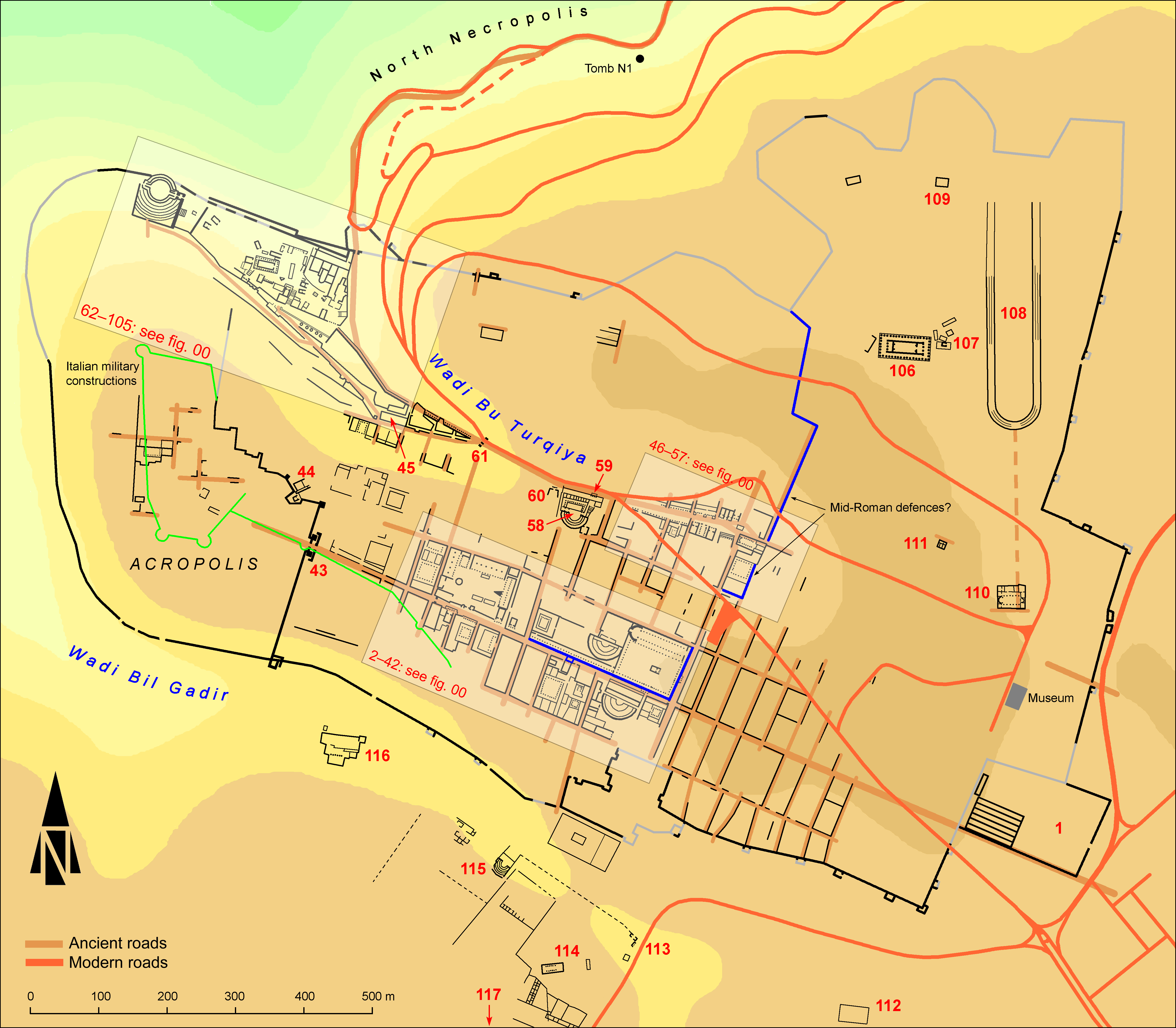EpiDoc XML:
IGCyr0920002
Trismegistos ID:
738444
Source description
Support: Two not joining fragments of a grey and white marble panel: fragment a (w: 0.135 × h: 0.01 × d: 0.05) being its left upper corner; fragment b (w: 0.23 × h: 0.11 × d: 0.05) keeping the lower margin and having many cuttings on front face.
Layout: Inscribed in four lines on front face.
Letters: 0.015 (beta) to 0.008 (omicron); beta with equal loops, slantering sigma, small omicron, very slight serifs.
Date: Between ca. 305 and 290 BC (Rosamilia) (lettering, prosopography).
Findspot: Fragment b, mentioned in C. Anti's sketchbook, should have been found between 1925 and 1930; nothing is known about fragment a, but both were found at Cyrene ➚; no exact findspot is recorded.
Place of origin: Findspot.
Last recorded location: Cyrene Museum, 266+252. Seen by Pugliese Carratelli in 1960 in Shahat: Cyrene Museum. Seen by C. Dobias-Lalou in 1976 at the same place.
Text constituted from: Transcription from stone (CDL).
Bibliography
SECir, 123 (fragm. a); Oliverio , VII.28, whence SECir, 176 (fragm. b); together Dobias-Lalou 2003, pp. 211-216; and Chaniotis 2006, n. 44, whence SEG, 53.2049; IGCyr 092000 ➚; Rosamilia 2023, pp. 101-102 (prosopogrpahy), pp. 369-370, number 95 (text).
Text
Apparatus
1a: Ἄναξ[---] SECir: Ἄναξ[ι καὶ τοῖς θεοῖς] SECir; Ἀνάξ[οιν καὶ τοῖς θεοῖς] SECir
1b: Ἀναξέα (vac. 4?) Dobias-Lalou 2003 or Ἀναξέα[ν] (vac. 3?)?: Ἀναξέα[ς] SECir
2a: σὺμ Βα̣[καλι?] Dobias-Lalou 2003: συμβω̣[μ---] SECir; Βά̣[ττωι?] Dobias-Lalou 2003; Βα̣[ιέαι?] Dobias-Lalou 2003; Βα̣[ίωι?] Dobias-Lalou 2003; σὺμ Βα̣[καλι?] Dobias-Lalou 2003
2b: Αἰγλάν[ο]ρ̣ο̣ς̣ [συν] Dobias-Lalou 2003: Αἰγλάνο̣ρος [---] SECir
3a: ἱαριτε[ύοισα] Dobias-Lalou 2003: ἱαριτε[υ---] SECir
3b: Ἀφ̣ρ̣[οδ]ίτα̣ι Dobias-Lalou 2003: Ἀφ̣ρ̣[οδ]ίτ̣α SECir
4a: καὶ τ[ὰν] Dobias-Lalou 2003: καὶ τ[---] SECir
French translation
Anax[---] (scil. fille d'?)Anaxéas, prêtresse en même temps que Ba[kal?] fils d'Aiglanôr a consacré à Aphrodite (scil. ce monument) ainsi que la table de pierre.
English translation
Anax[---], (scil. daughter of?) Anaxeas, priestess with Ba[kal?] son of Aiglanor dedicated to Aphrodite (scil. this monument) as well as the stone table.
Italian translation
Anax[---], (scil. figlia di?) Anaxeas, sacerdotessa con Ba[kal?] figlio di Aiglanor ha dedicato ad Afrodite (scil. questo monumento) come pure la tavola di pietra.
Commentary
Pugliese Carratelli checked in the museum fragment a, of which he had found a copy in †Oliverio's papers. He also studied fragment b in the museum, but published it separately.
The restoration at ll. 3-4 of συνιαριτεύοισα gives a clue to the length of the other lines. This participle refers to a priestess of Artemis on duty during the same year as Apollo's eponymous priest, here mentioned (pace Chaniotis) at the dative case with σύν before the verb.
The priestess' name might be Anax[ippa], Anax[ilea] or else. Anaxeas might be her father's name at the genitive case, but might also be the name of the man whose statue was dedicated, whence at the accusative.
A man named Bakal son of Aiglanor is mentioned as nomophylax in Ptolemaios' diagramma (IGCyr0108002, line 81. His name appears also on the contemporary base IGCyr0964002. The restoration is thus very plausible at line 2.
The implicit monument bearing the panel should have been dedicated alongside with a stone (i.e. marble) table. It should be noted that at Perge in the Roman imperial period a woman was said to be τραπεζώ of Artemis (see Brixhe, Brixhe, BE, 2000.625).
For the last word, of which only the initial lambda survives, the lacuna should correspond to 5 characters. Therefore λ[ιθίναν], with two iotas is preferred to λ[υγδίναν]. The former describes the table as 'of marble', whereas the latter would more precisely mention the most precious marble, white and nearly transparent.
CC BY-NC-SA 4.0 Deed Attribution-NonCommercial-ShareAlike 4.0 International License.
All citation, reuse or distribution of this work must contain a link back to DOI: https://doi.org/10.60760/unibo/igcyrgvcyr2 and the filename (IGCyr000000 or GVCyr000), as well as the year of consultation.



